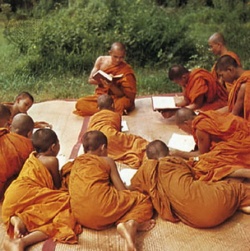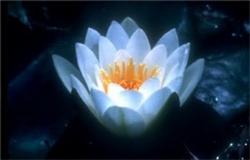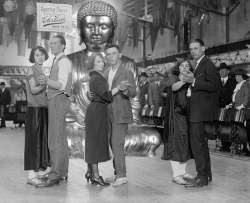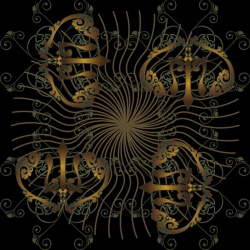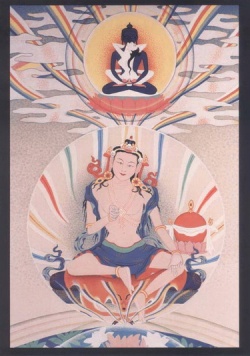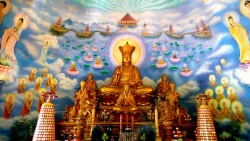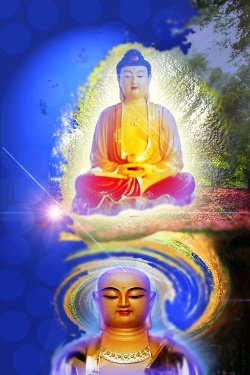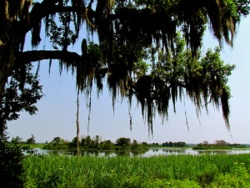Itineraries to Sambhala
by John Newman
From Tibetan Literature: Studies in Genre, pp. 485-499.
Introduction
[page 485] Tibetan travellers wrote accounts of their journeys called lam yig, which we may translate as "route descriptions," or "itineraries." Such texts are a subspecies of the genre Turrell V. Wylie appropriately designates "religious geography."1 In the introduction to his history of Buddhism in A mdo, Brag dgon zhabs drung dKon mchog bstan pa rab rgyas (nineteenth century) lists a number of these itineraries,2 several of which are extant and have been studied by Western scholars:
(1) rGya gar lam yig ("Itinerary to India") of Chag Chos rje dpal (1197-1264) (Roerich, 1959 and LSDMG).
We should also mention the rGya gar gyi gnas chen khag la bgros pa'i lam yig (first ed., Calcutta: The Mahabodhi Society, 1939) of the remarkable polymath dGe 'dun chos 'phel (1905-1951). This modern pilgrim's guide to India includes such information as train fares and mileage, as well as still valuable scholarly notes on the sacred sites he visited.
Tāranātha's account of the travels of his Indian guru Buddhagupta, the Grub chen bu ddha gu pta'i rnam thar rje btsun nyid zhal nas gzhan du rang rtog gi dri mas ma spags pa'i yi ge yang dag pa, studied by Tucci (1931), is not strictly speaking a lam yig, but it contains much interesting information on India and[page 494] other regions. Tucci (1931: 684) notes that this is one of the main sources for the geographical information found in the Sham bha la'i lam yig of Paṇ chen Blo bzang dpal ldan ye shes, referred to below.
(2) Bal yul gyi lam yig ("Itinerary to Nepal") of lHa mthong bShes gnyen rnam rgyal (born 1512).I do not know if this has any relation to the Bal yul gnas yig or the Bal yul mchod rten 'phags pa shing kun dang de'i gnas gzhan rnams kyi dkar chag, both edited by Wylie (1970: 37-48); see also Kaschewsky.
(3) rDo rje gdan gyi lam yig ("Itinerary to Vajrāsana," i.e., Bodh Gaya).See Jackson: 223-224; Jackson #1510, BRS bundle no. 590: rDo rje ldan gyi dkar chag dang lam yig. Jackson hypothesizes that this text may be by Chag Chos rje dpal (see above), but his analysis of its contents differs markedly from the LSDMG.
(4) O rgyan lam yig ("Itinerary to Uḍḍiyāna," i.e., Swat), presumably that of U rgyan pa Rin chen dpal (1230-1309) (Tucci, 1940).In this work Tucci also studies the Orgyan mkha' 'gro'i gling gi lam yig thar lam bgrod pa'i them skas of sTag tshang ras pa (a.k.a. Orgyan pa) Ngag dbang rgya mtsho (seventeenth century). For further information on U rgyan pa Rin chen dpal see Roerich, 1974.
(5) Sha mbha la'i lam yig ("Itinerary to Sambhala") of Man lung Guru and Chos rje 'Byor ldan grags pa (see below).
Several well-known lam yig are noticeably absent from dKon mchog bstan pa rab rgyas's list, e.g.:[page 486]
(1) Po ta la'i lam yig ("Itinerary to Potala") (Tucci, 1948-51: 179-186).
(2) Kalāpāvatāra (KA; Tib. Ka lā par 'jug pa, "Itinerary to Kalāpa," the capital of Sambhala) (see below).
(3) Grub pa'i gnas chen po shambha la'i rnam bshad 'phags yul gyi rtogs brjod dang bcas pa ngo mtshar bye ba'i 'byung gnas zhes bya ba (NTBBN; a.k.a. Shambha la'i lam yig) of Paṇ chen Blo bzang dpal ldan ye shes (see below).
Although all of the above lam yig are mainly concerned with pilgrimage—travel to Buddhist sacred sites—when we compare the two groups of itineraries we notice that the journeys they depict are qualitatively different. The first group describes straightforward routes open to the ordinary traveler. The latter journeys are reserved for the tantric adept (siddha, grub thob) who has the magic powers necessary to overcome natural and supernatural obstacles on the way. Both types of lam yig are represented among the itineraries to Sambhala.3
Notes
[1] "These texts are intended primarily to describe the geographical location and religious history of pilgrimage places, sacred objects, and the hermitages of former Buddhist holy men. They are devoid of specific information on physical geography per se and are better understood when thought of as guide-books for pilgrims visiting unfamiliar places and things" (Wylie, 1965: 17; cf. 1970: xv; Vostrikov: 217).
[2] Chag lo'i rGya gar lam yig / Bal yul gyi lam yig Lha mthong lo tsā bas mdzad pa / rDo rje gdan gyi lam yig / O rgyan lam yig / Man lung gu ru dang / Chos rje 'byor ldan grags pa'i Sha mbha la'i lam yig / (DTGT: 20.4-5); cf. Vostrikov: 231. I am grateful to Dan Martin for drawing my attention to this passage.
[3] The Sanskrit Kālacakra literature spells this name sambhala; the Tibetans transliterated it as sham bha la. For the sake of consistency we follow the Sanskrit, except in the titles of Tibetan texts.
Sambhala
To understand the development of the Tibetan itineraries to Sambhala we must first examine the notions of Sambhala found in earlier Hindu and Buddhist Indian literature. The toponym "Sambhala" first appears in the Hindu prophetic myth of Kalki in the Mahābhārata and the Purāṇas. In Hindu texts Sambhala is a Brahman village, of undetermined location, that will be the birthplace of Kalki, the future messianic incarnation of Viṣṇu. At the end of the current degenerate Kali age, it is said, Viṣṇu will incarnate as the pious Brahman warrior Kalki, who will rid the earth of barbarians and unruly members of the lower castes. Kalki's apocalyptic war will purify the world, re-establish Brahman dominance of the social order, and thus institute a new age of righteousness (see, e.g., O'Flaherty: 235-237, 333).
The Vaiṣṇava myth of Kalki was borrowed and adapted by the authors of the Indian Buddhist Kālacakra ("Wheel of Time") Tantra literature. In the Kālacakra texts Sambhala is no longer a mere village—it is a mighty kingdom at the center of a vast empire consisting of ninety-six great lands and more than a billion villages (Newman, 1987: 289, 298, 307, etc.; cf. 1985: 54-58). This Buddhist Sambhala is the homeland of a long dynasty of bodhisattva kings[page 487] known by the title kalkin (Tib. rigs ldan), an epithet which in the Buddhist literature means "chieftain." It is prophesied that at the end of the Kali age the last Buddhist kalkin, Raudra Cakrin, will lead the army of Sambhala in a great holy war that will obliterate the forces of Islam (Newman, 1985; 1987: 578-654; 1989a; 1989b).
We are confronted here with a case of religious syncretism: the Buddhists have appropriated a Hindu myth and refashioned it to suit their own purposes. With this sort of birthright one would expect the Buddhist Sambhala to be a mere phantasm, and any effort to locate it an exercise in futility. In fact, things are not so simple.
The Indian Kālacakra literature gives clear indications of the location of its Sambhala. Sambhala is north of India, and it is north of the Śītā River, which we may identify with the Tarim River in Eastern Turkestan.4 Also, a passage dealing with astronomy clearly locates Sambhala relative to other identifiable countries: Sambhala is on a latitude to the north of Tibet, Khotan, and China.5 If we combine these two pieces of information, that Sambhala is to the north of China, and is north of the Tarim River, we see that the Indian Kālacakra literature locates Sambhala in the region north of the Tian Shan.
The question arises, why did the authors of the Indian Kālacakra literature adopt the Hindu myth of Sambhala, transform it into a mighty kingdom, and locate it in Central Asia? The Kālacakra's mythic history was devised in part as a response to contemporaneous (early eleventh century) Muslim incursions into northwestern India. It displays an acute awareness of the threat the new ideology of Islam posed for Buddhists and Hindus alike. Thus, the Indian Buddhist myth of Sambhala was fashioned partly as a reaction to current religio-political conditions: the Kālacakra countered the Muslim raids on northwest India with an apocolyptic vision of a holy war to be carried out by a bodhisattva messiah from Central Asia (Newman, 1985: 78-80; 1987: 626-638; 1989a; 1989b).
Almost simultaneous with its introduction in India, Tibetans became ardent followers of the Kālacakra.6 Given the fairly clear indications of Sambhala's geographical location in the Kālacakra literature, it is not surprising that Tibetans should be interested in the route to this holy land.7[page 488]
Notes
[4] Newman, 1987: 309. The Śītā is the northern river of the four great rivers of traditional Buddhist cosmography (Abhidharmakośabhāṣya 3.57). Hsüan-tsang (Beal: I.12-13 and s.v.), Man lung Guru (Laufer: 404; also, see below), and the bTsan po No mon han (Wylie, 1962: 58) all describe the Śītā in ways that correspond to the Tarim, and H.W. Bailey (5) concurs with this identification.
[5] ...boṭa lī ca cīnādideśesu...sambhalaviṣayāntam.... (Vimalaprabhā: 40a1-2).
[6] Indeed, the appearance of the Tibetan word li ("Khotan") in the Sanskrit text of the Vimalaprabhā (see note 9) indicates its author was familiar with, and perhaps had contact with, Tibetans. Other passages in the Vimalaprabhā also support this hypothesis: see, e.g., Newman, 1987: 362.
[7] The Tibetan itineraries to Sambhala have been extensively studied by Edwin Bernbaum (1980, 1985). The following discussion is indebted to his fine research, but our conclusions about the history and significance of Man lung's lam yig and the Kalāpāvatāra differ on several fundamental points, as noted below.
The rMi lam rdzun bshad sgyu ma'i sgra dbyangs chen mo
The earliest datable Tibetan itinerary to Sambhala is that of Man lung Guru (born 1239).8 We do not know what form Man lung Guru's itinerary originally circulated in—as we have it today it is embedded in the fourth chapter (ff. 15a3-17b1) of an anonymous work entitled rMi lam rdzun bshad sgyu ma'i sgra dbyangs chen mo (MLDS).9 This lam yig describes the route to Sambhala in rather matter-of-fact terms: One leaves Bhaktapur, Nepal (Tib. Khu khom)10 and travels north to the region of Khotan (Li yul). Nearby is the Tarim River (Shing rta, i.e., the Śītā), which flows from west to east, and in this region live the Uighurs (Hor). North of the Tarim lie the mountains (the Tian Shan) that make up the southern boundary of Sambhala. Sambhala is a general name for northern portions of "small Jambudvīpa," the Kālacakra designation for what we would call Central Asia (MLDS: 15a3-15b1).
The lam yig also gives an alternative route to Sambhala: From central Tibet one travels to mNga' ris Mang yul in western Tibet. From there one goes to Turkestan (sTod hor gyi yul), and on to the lands of the Mongols (Sog po'i yul), finally reaching the center of Sambhala in no more than two or three years (MLDS: 17a4-5).
The author of this itinerary claims personally to have seen the king of Sambhala deliver a religious sermon to a large audience (MLDS: 16a4-6), and he takes great offense at sceptics who would doubt the credibility of his knowledge of Sambhala (MLDS: 19b1-20a1). At the same time, he accuses the Sa skya hierarch 'Phags pa of having fabricated an extensive account of Sambhala in order venally to deceive (zog 'tshong) the Mongol emperor, presumably referring to Qubilai Khan.11
The lam yig's description of Sambhala is a curious mélange of elements drawn from the canonical Indian Kālacakra literature (primarily the Vimalaprabhā), erstwhile realia (the architecture, diet, and clothing of the Sambhalese), and the obligatory travellers' sexology.12 However, there is nothing extraordinary about the actual route to Sambhala—it is presented as though any Tibetan with sufficient yaks and roasted barley flour could go there. Things are quite different with the next lam yig we will examine.[page 489]
Notes
[8] The Blue Annals states that Man lungs pa was born in 1239, and went to Potala in 1300 (Roerich, 1974: 790-791).
[9]
Bernbaum (1985: 37-38), who discovered a manuscript of the text, refers to it as the Śambhala pa'i lam yig, and believes the entire text is the work of Man lung Guru. In fact the title page (1a1) and the final colophon (20a1-2) of this manuscript give the title as Śham bha la pa'i lam yig, which we might translate as "The Itinerary of the Man Who Went to Sambhala"—this no doubt refers to Man lung Guru's itinerary contained in the fourth chapter. However, this title appears nowhere else in the manuscript, and the colophons to all of the five chapters (11b5, 13b1, 15a2, 17a6, 19b1) give the title as rMi lam rdzun bshad sgyu ma'i sgra dbyangs chen mo, "The Great Melody of Illusion, the False Account of a Dream." (This title derives from the author-redactor's view that empirical reality is illusory—thus, even the factual geographical[page 495] information that makes up most of the text is, in some profound epistemological sense, false.) Also, Sambhala is not even mentioned in the other four chapters, which describe journeys to the East (China,
chapter 1), the South (India and Potala,
chapter 2), the West (Uḍḍiyāna,
chapter 3), and the Center (Tibet,
chapter 5).
I believe rMi lam rdzun bshad sgyu ma'i sgra dbyangs chen mo is the main title of the text, and suspect Sham bha la pa'i lam yig is a subtitle affixed to call attention to the most rare or interesting itinerary it contains.
We can assume that Man lung Guru's lam yig forms the basis for the fourth chapter of MLDS because Paṇ chen Blo bzang dpal ldan ye shes refers to Man lung Guru's account in ways that correspond exactly to this chapter (NTBBN: 34a3-6; cf. 41b3-4; at 50a2 he refers to rJe Shambha la pa, apparently indicating Man lung Guru. See also LSGK: 5a3-5b1; NCKSML: 202b5-6).
However, the work as a whole is a synthesis of various travellers' accounts—it refers to journeys of Urgyan pa Rin chen dpal (1230-1309), 'Phags pa (1235-1280), and Red mda' ba gZhon nu blo gros (1349-1412). It also mentions the third Ming emperor of China, Yung-lo, who reigned early in the fifteenth century—thus it could not be the work of Man lung Guru. The name of the author-redactor is not given in the manuscript. However, dKon mchog bstan pa rab rgyas's linkage of Man lung Guru with Chos rje 'Byor ldan grags pa (see note 2) may suggest the latter's redaction of the text. This and a host of other issues raised by the MLDS await further study. For previous study of the Sambhala chapter of the text see Laufer: 402-407; and Bernbaum, 1985: 37-39.
[10] Our manuscript reads khu khom, Laufer's (404) has the form khom khom. I assume these are both variants of the apparently more common form kho khom: see Wylie, 1970: 13, n. 11; Kaschewsky: 435.
[11] yul 'di'i zhib rgyas 'tshad [read: 'chad] tshul ni / sa skya pa chos rgyal 'phags pas hor rgyal po la smras pa de zog 'tshong phyir yin par mngon no // (MLDS: 17a3).
[12]
For example, the lam yig reports that people in a large city south of the border of Sambhala reproduce in an unusual hermaphroditic fashion. All of the citizens possess male genitals in their right thighs, and female in their left. After a mere three months gestation, the child is born from the left thigh (MLDS: 15a5-15b1).
In his own lam yig Paṇ chen Blo bzang dpal ldan ye shes, obviously following Man lung Guru, merely avers that hermaphrodites dwell on the border of Sambhala (NTBBN: 41b3-4). Yet in his LSGK (5a3-5b1) he asserts that this feature of Man lung Guru's lam yig is bizarre, and does not appear in the authoritative (tshad ldan) sources such as the Kalāpāvatāra, which he claims to follow. Help in the resolution of this contradiction may be found in the editor's colophon to NTBBN (50a4-5). There it is reported that the Paṇ chen had said the NTBBN needed revision, but the revision had not been carried out. It is possible that the NTBBN was written first, and the LSGK represents the Paṇ chen's later view, which further devalues Man lung Guru's account.
The Kalāpāvatāra
We do not know when or where the Kalāpāvatāra (KA) was composed,13 but the Tibetans first came to know of it when it was translated from the Sanskrit by rGyal khams pa Tāranātha (1575-1634). Tāranātha's colophon states that he translated the text from a Nepalese manuscript, and received assistance on difficult points from a Brahman pandit named Kṛṣṇa.
The KA is an unusual and interesting piece of literature, a sort of tantric Baedeker.14 It begins like a Buddhist sūtra, describing Mañjuśrī dwelling on a mountain named *Mahendra. Avalokiteśvara goes there, and by means of a dialogue the two impart myriads of Mahāyāna teachings to the gods, demons, ghosts, dragons, and humans there. Five hundred people of Kośala, Vaiśālī, Videha, and Mithilā hear of this conversation and go to Mount *Mahendra. Since Mañjuśrī does not appear, they ask Avalokitesvara for instruction. Avalokiteśvara is pleased with their request, and he induces Ekajaṭā to request the discourse from Amoghāṅkuśa, who proceeds to describe the route to Kalāpa, the capital of Sambhala.
Amoghāṅkuśa notes that, in the future, knowledge of the Dharma will degenerate [in India), but it will be preserved in the north, in Kalāpa on Mount Kailāsa [in Sambhala). There the people are happy and righteous, and all the sūtras and tantras of the Mahāyāna are preserved. A tantric practitioner (sādhaka) who seeks magical attainments (siddhi) both for himself and for others should propitiate his chosen deity for permission to travel to Kalāpa. Without permission he will certainly meet disaster.
Having gained authorization, the practitioner should recite one million mantras, and make more than one hundred thousand fire offerings to various deities. Again, without successful completion of these rites, the traveller will not reach Kalāpa, but will be punished by dragons, ghosts, and goblins on the way. The traveller then goes to the tree where the buddhas achieve enlightenment [at Bodh Gaya), worships the tree, and departs on his journey. He first goes west, takes a ship to an island, and worships a stūpa of the former Buddha Kanakamuni. Having returned to India, the pilgrim heads northeast, and then north, for six months. On a mountain named Kakari, the traveller must dig some roots while[page 490] reciting the appropriate mantra, dry the roots, paint an image of the pig-faced goddess Mārīcī on a white slab of stone, and recite her mantra, requesting her to overcome obstructors and protect the practitioner. The traveller then grinds the roots and concocts a medicinal elixir. Having recited the mantra and worshipped the goddess, he drinks the drug, achieving freedom from hunger, thirst, and fatigue.
Further legs of the journey entail propitiation of demonesses: the bloody worship of Mandehā provides the traveller with food to cross the desert; *Vidyuccalā enables him to cross the frigid river Śītā. Additional mantra recitation and consumption of plant materials purify the practitioner's body, making it light and powerful. Throughout this process, it is imperative that the traveller have the right attitude of dispassionate altruism. Armed with this, and performing more rituals and overcoming more obstacles, the traveller is eventually carried to Kalāpa in the arms of sorceresses.
Kalāpa is a marvelous place, a paradise on earth. The people are free from evil, ignorance, and want, and live happy lives of at least one hundred years. Equal to its worldly delights, however, are the spiritual qualities of Kalāpa. There the accomplished practitioner will achieve transcendent and mundane siddhis merely by paying homage to the sacred king; less advanced adepts will receive instruction from him, enabling them quickly to attain their goals.
Having heard this wonderful discourse, the five hundred fortunate people return to their homes and teach it to others. Then they use its method to travel to Kalāpa, where they achieve siddhi. So ends the Kalāpāvatāra.
The KA is a very different sort of itinerary than the MLDS. Whereas the MLDS describes a route we can trace on a map, the KA traverses the realm of spiritual imagination. In the KA "real" physical geography is almost irrelevant—freezing rivers, lofty mountains, and vast wastes are for the most part unrelated to identifiable features of the earth's surface; they merely provide obstacles to be overcome through ritual purification and empowerment.15 While the KA and the MLDS have the same goal—access to the religious teachings of Sambhala, their means are radically different. Any traveller can follow the path described by Man lung Guru; only an adept of tantric magic can hope to reach Kalāpa via the route described in the Kalāpāvatāra.[page 491]
Notes
[13]
Bernbaum believes that (1) the verse sections of the Kalāpāvatāra are interpolated into a older prose original; (2) it contains no clear reference to the[page 496] Kālacakra tradition existing in Sambhala; (3) it probably predates the Kālacakra tradition, perhaps even predating Islam; and (4) the KA itself probably influenced the primary texts of the Kālacakra tradition—the Śrī Kālacakra and the Vimalaprabhā (Bernbaum, 1985: 128-133; cf. 28, 80-81, 102, 115-116).
I see no evidence to support any of these hypotheses. (1) It is extremely problematic to attempt to stratify a Sanskrit text based solely on features of its Tibetan translation. In any case, the verse sections simply frame and elaborate on the prose narrative. This is common practice in Sanskrit literature—it provides no evidence for stratification. (2) The KA in fact refers to the Paramādibuddha-tantra (Dam pa dang po'i sangs rgyas rgyud)—the Kālacakra mūlatantra—as existing in Kalāpa, the capital of Sambhala (KA: 317a4-5; cf. Bernbaum, 1985: 93, n.140). (3) Thus, the KA could not predate the Kālacakra tradition. (Given its content, if the KA predated Islam we would have to entirely rewrite the history of late Indian Buddhism.) (4) There is no evidence that the KA influenced the Śri Kālacakra and the Vimalaprabhā; it is certainly simpler to assume the opposite to be true. (Cf. Newman, 1987: 195-206.)
Given the facts that the earlier Indo-Tibetan Kālacakra tradition exhibits no awareness of the KA, that it was not translated into Tibetan until the seventeenth century, and that Tāranātha specifies that it was translated from a Nepalese manuscript, it is possible that the KA is a product of medieval Newar Buddhism. Comparison of the deities and rituals of the KA with those of the Newars may support this hypothesis. On the other hand, the introduction to the KA (315b7-316a1) indicates that the legendary human audience of the sermon contained in the KA came from Kośala, Vaiśālī, Videha, and Mithilā. We know from manuscript colophons that vestiges of the Kālacakra tradition survived in this region at least into the fifteenth century, and it is possible that the KA originated there.
[14] For a complete translation of the KA see Bernbaum, 1985: 44-80.
[15] Although a few of the toponyms and geographical features of the KA's route may be correlated with real entities, I have the impression that most are the products of literary imagination. Bernbaum (1985: 181-194) has shown that a portion of the KA draws on the journey to Uttarakuru episode of the Rāmāyaṇa.
The Shambha la'i lam yig of Paṇ chen Blo bzang dpal ldan ye shes
The Grub pa'i gnas chen po shambha la'i rnam bshad 'phags yul kyi rtogs brjod dang bcas pa ngo mtshar bye ba'i 'byung gnas (NTBBN) (composed 1775), more commonly known as the Shambha la'i lam yig, of the third Paṇ chen Lama, Blo bzang dpal ldan ye shes (1738-1780), is the best known of the itineraries to Sambhala, no doubt due to the fact that it was the first to be translated into a European language (Grünwedel; cf. Vostrikov: 231-232; Bernbaum, 1985: 42-44 et seq.). In fact only about a fifth of the text is devoted to the actual route to Sambhala—most of it is taken up by a description of India and its political and religious history, and the remainder by an account of Sambhala and its political and religious history (cf. Vostrikov: 232). As Bernbaum (1985: 42-80) has shown, the Paṇ chen Lama's version of the journey to Sambhala is a very close, often verbatim, restatement of the KA's description—thus, it contains little of independent intrinsic interest.
More interesting than the Paṇ chen's route to Sambhala, however, is his attitude toward the accessibility of this marvelous land. Subsequent to Tāranātha's translation of the KA, Tibetans had available two entirely different descriptions of the way to Sambhala: the "realist" itinerary of Man lung Guru, and the "spiritual" route of the KA. Given the choice, the Paṇ chen opted decisively for the latter. In the NTBBN he says: "If you wish physically to travel to (Sambhala), you must definitely have achieved the power of mantras and merit. Otherwise, the goblins, fierce nāgas and so forth will kill you on the way" (NTBBN: 34a2-3, cf. 34a6-35a4, 48b6-49b1; SZKBT: 4a5-6). Furthermore, the Paṇ chen explicitly compares the "authority" of the KA and the MLDS: he notes that Man lung Guru's lam yig is very easy to follow, and it contains many things that are not in accord with the "authoritative" (tshad ldan) itinerary, the KA—in brief, only the KA is authoritative, all other lam yig are false (rdzun ma) (LSGK: 5a3-5b1, 6a2-3; cf. NTBBN: 35a2, 50a1-2).
Why did Paṇ chen Blo bzang dpal ldan ye shes choose the metaphysical instead of the physical route to Sambhala? At least two possibilities come to mind. One is given by the fourth bTsan po No mon han sprul sku 'Jam dpal chos kyi bstan 'dzin 'phrin las (1789-1838) in his 'Dzam gling chen po'i rgyas bshad snod bcud kun gsal me long (NCKSML: 202a1-203a6). The bTsan po No mon han[page 492] asserts that the Sambhala taught in the Kālacakra Tantra is an "emanated city" (sprul pa'i sgrong khyer), and thus appears to ordinary beings in different ways. The extremely difficult route described in the KA is for the traveller seeking tantric siddhi, he says, but that does not exclude there being other ways to go there. For example, the Po ta la'i lam yig requires the traveller to journey under the sea and through space to reach Avalokiteśvara's palace on Potala (cf. Tucci, 1948-51: 179-187), yet Buddhagupta went there with merchants in a boat (cf. Tucci, 1931: 693). Thus, although its brevity makes it difficult to find the center of Sambhala, Man lung Guru's easy itinerary does provide a viable route to Sambhala. However, if non-Buddhists are given easy access to Sambhala, there is a danger that Sambhala itself could eventually be overrun by barbarians: this, the bTsan po No mon han says, is the reason Paṇ chen Blo bzang dpal ldan ye shes taught that one should not encourage people to travel to Sambhala.
While the Paṇ chen's concern for the sanctity of Sambhala may help us to understand his preference for the KA over Man lung Guru's itinerary, we may conjecture that other motives were also at work. Paṇ chen Blo bzang dpal ldan ye shes was considered by his followers, and perhaps by himself, to be a "pre-incarnation" of Kalkin Raudra Cakrin, the prophesied apocalyptic king of Sambhala.16 By the second half of the eighteenth century the geography of the Turkic and Mongol lands was becoming more familiar to the Tibetans, and in reading the Paṇ chen's account of Sambhala one senses some uneasiness that such a vast empire was apparently nowhere to be found. Under these circumstances Man lung Guru's itinerary was something of an embarrassment. If the realistic route to Sambhala led not to a grand Buddhist empire, but to a virtual wasteland sparsely inhabited by nomads, what did this say about the Paṇ chen's future role in the Buddhist apocalypse? Better to assert that Man lung Guru's account is "false," and to protect the sacred utopia with a veil of ritual magic.17
Notes
[16] See the full title of the Shambha la'i smon lam ("The Prayer [to be reborn) in Sambhala"): "The prayer to be reborn at the head of the entourage when in the future the supreme reverend lama himself [i.e., Paṇ chen Blo bzang dpal ldan ye shes) takes up the form of Raudra Cakrin in Sambhala and performs marvelous deeds"—rJe btsun bla ma mchog nyid ma 'ongs dus shambha lar drag po 'khor lo'i skur bzhengs nas ngo mtshar ba'i mdzad pa ston skabs 'khor gyi thog mar skye ba'i smon tshig (KTKMT). Chief among the "marvelous deeds" is the annihilation of the barbarian Muslims, as mentioned above.
[17] Some contemporary Tibetans have adopted similar strategies when confronted by modern geography. They have placed Sambhala under the Arctic ice, on another planet, or in the realm of invisibility (Bernbaum, 1980: 31-39).
Conclusion
The lam yig genre reflects both the religious and the geographical interests of the Tibetans. On the one hand, the Tibetans inherited a concern for sacred geography—as opposed to physical geography—along with the Indian Buddhist worldview that dominates[page 493] classical Tibetan culture. The Indian itineraries in Tibetan translation (Kalāpāvatāra and Po ta la'i lam yig) treat physical geography as a virtually irrelevant backdrop for journeys of the spirit. However valuable they might be to an adept in magic, they are practically worthless for the conventional traveller.
Indigenous Tibetan lam yig, on the other hand, display a sense of pragmatism that is absent from the Indian texts. Tibetan itineraries are also inspired by religiosity—they describe arduous, life-threatening pilgrimages to Buddhist holy places, and they are spiced with anecdotes of strange and miraculous people and places on the way. However, there is nothing mysterious about the route descriptions they contain: they are clearly conceived as realistic accounts of actual journeys to be duplicated by other ordinary pilgrims; we can trace their routes on a map.18 This practical concern for factuality within the context of religious endeavors (also noteworthy in the Tibetan historiographic tradition) distinguishes the Tibetan lam yig from its Indian antecedents. A tendency to coordinate spiritual imagination with empirical reality is an important characteristic of the Tibetan adaptation of Indian Buddhist culture.
Notes
[18] The lam yig section of the Paṇ chen's NTBBN is an exception to this rule, but even the NTBBN includes factual geographical information—obtained from British travellers in Tibet—elsewhere in the text (Vostrikov: 232).[page 497]


